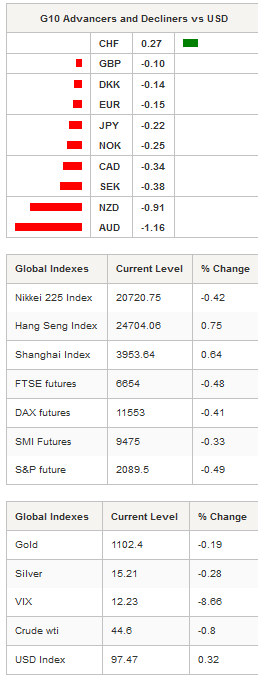Market Brief
It seems that July’s foreign trade data were the last straw for China’s patience towards a sluggish economy. The PBoC decided to step up a gear and cut the yuan’s daily fixing by 1.9% to 6.2280 earlier this morning. It’s no coincidence that this decision came in almost one week after the IMF suggested delaying a decision to include the yuan in the SDR basket, we expected the bank to continue stimulating the economy but we were betting on an adjustment on the reserve requirement ratio or the 1-year lending rate. China is clearly playing the competitive devaluation card and joined the ongoing currency war. On the data front, China’s new bank loan rose by CNY1480bn versus CNY750bn median forecast and CNY 1279.1bn previous reading. M2 money supply growth increased 13.3% in July from 11.8% in June and 11.7% consensus.

The PBoC decision affected heavily the Asian regional currency exchange rate with the AUD, CNY, KRW and TWD/ down more than 1% versus the US dollar. The highly China sensitive Aussie dropped as much as 1.80% versus the greenback, as NAB Business confidence fell to 6 from 10 a month earlier, while the NZD/USD fell 1.30%. On the equity front, Asian equity markets are mostly trading into negative territory with the Japanese Nikkei down -0.42%, S&P/ASX 200 down -0.65%, New Zealand shares -0.73% and South Korean’s KOSPI -0.82%. On the other hand, Shanghai Composite is up 0.64%, SZSE Composite gains 1.38% while Hong Kong’s Hang Seng adds 0.75%.
In Europe, the picture is not brighter with German DAX losing -0.41%, CAC 40 -0.51%, Euro Stoxx 50 -0.52%, FTSE -0.48% and SMI -0.33%. Yesterday, the dollar was broadly lower after Fed’s Vice Chairman, Stanley Fischer, said inflation levels remain low despite a job market near the sweet spot. He declared “And the concern about this situation is not to move before we see inflation, as well as employment, returning to more normal levels”. EUR/USD reached 1.1042 in New York, up 1% over the day, and failed to break the 1.1049 level (Fib 38.2% on June-July debasement) to the upside. The euro finally stabilised lower around 1.0970 after the PBoC’s announcement. The pound sterling followed almost the same pattern and gained 1% against the US dollar before stabilising around 1.5560.
USD/CHF is taking a breather after a 2-month bull run and is stumbling over the 0.9863 resistance level (high from April 13) and is currently stabilising slightly lower. The dollar will find a strong support around 0.9540 (200dma) and 0.9463 (Fib 38.2% on January-March rally). EUR/CHF is also stumbling over a key resistance level. The euro has been proven unable to break the strong resistance implied by the high from February 20 at 1.0812 and the 200dma currently at 1.0868. However, we expect the Swiss franc to weaken further against those two currencies due to the economic divergence between Switzerland and the US and the Eurozone.
Today traders will be watching ZEW survey from Germany and Eurozone; CPI from Italy; housing starts from Canada; wholesale inventories from the US; trade balance from India; weekly inflation figures from Brazil.
Currency Tech
EUR/USD
R 2: 1.1436
R 1: 1.1278
CURRENT: 1.1018
S 1: 1.0819
S 2: 1.0660
GBP/USD
R 2: 1.5930
R 1: 1.5803
CURRENT: 1.5581
S 1: 1.5330
S 2: 1.5171
USD/JPY
R 2: 135.15
R 1: 125.86
CURRENT: 124.89
S 1: 120.41
S 2: 118.89
USD/CHF
R 2: 1.0129
R 1: 0.9863
CURRENT: 0.9808
S 1: 0.9526
S 2: 0.9072
